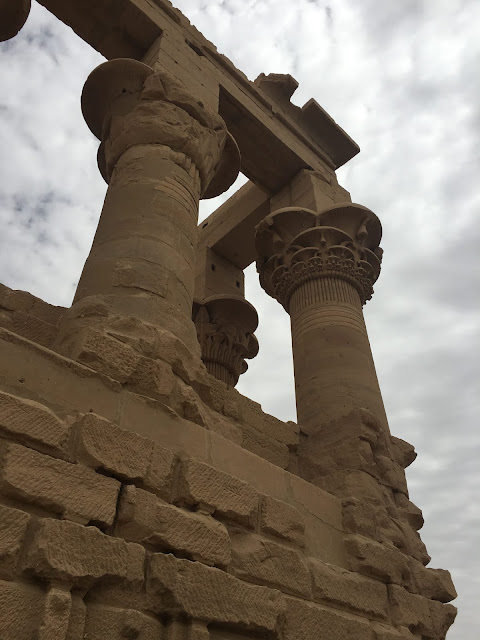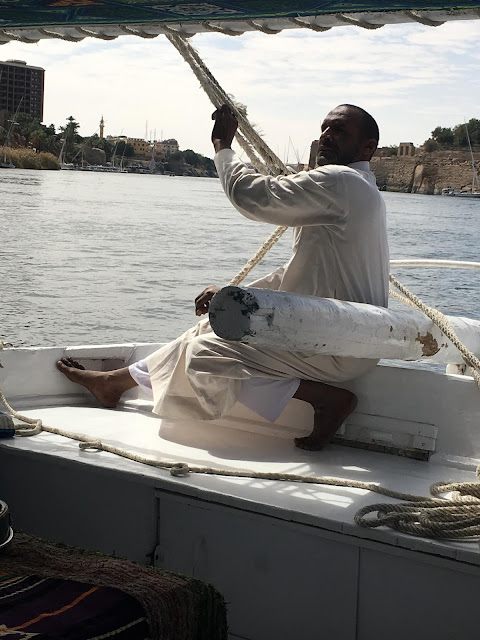We stopped first at the Edfu Temple of Horus, son of the gods Osiris and Isis. Horus was the falcon god, and his statues are throughout the area.
The cobra symbol of sovereignty, royalty, deity, and divine authority of the pharaoh in ancient Egypt.
Lotus blossoms
The next stop on the way to Aswan was Kom Ombo Temple and the Crocodile Museum next to it. This temple was dedicated to both the crocodile god Sobek and to the falcon god Haroeris.
Here's a relief of a sacred crocodile. Numerous mummified crocodiles were discovered in this area and are displayed in the museum next to the site. However, no photo-taking was allowed in the museum.
This complex is located right on the east bank of the Nile. I'm sure it is an imposing structure from the river when seen as one sails by.
Our excellent Egyptian guide, Deena, explaining what we were seeing.
After all the temple visiting we'd done, many of us were beginning to feel "templed out." Was the company name on the side of our bus somehow appropriate?
Next stop -- Aswan. After checking in to our hotel (which had a magnificent view including the Nile) and resting up a little, we were free to explore Aswan.
We also walked by the famous Cataract Hotel, where Agatha Christie and other notables stayed in the past. To visit the grounds, you have to pay a voucher fee, which is essentially a guarantee that you will purchase something there. We chose to pass.
We arrived back just in time for a beautiful unset view from our hotel.
A remarkable feature at this quarry is an unfinished obelisk, which appears to have cracked in the process of being removed, and subsequently was abandoned.
There are many unanswered questions about how these enormously heavy pieces of stones were cut and transported. One theory is that pieces of wood were wedged in cut-out openings under the stone, once the sides were cleared. The wood was then soaked with water, causing it to swell and thus popping the stone free. Whatever the case, the undertaking was mammoth.
Our next destination required another boat ride to get there, since it is located on an island.
This is the Temple of Isis, which was moved from Philae island to Agilika Island after the lower Aswan Dam flooded the original site. The lower dam was built in 1902. I cannot imagine how this incredible feat was done. Everything had to be dismantled and rebuilt in its new, higher location.
Here you can see where the water level was before the moving took place.
During the Byzantine era, the temple was transformed into a Christian place of worship, as you see indicated by the Coptic crosses below.
Below the cross is some ancient graffiti. Someone carved his name, and the next person called him stupid. What's changed today?
The next relief is particularly interesting as it shows the goddess Isis breastfeeding her son Horus.
The island is home to many well-fed cats who are obviously comfortable with visitors.
We really enjoyed the quiet beauty of this temple's location.
Next, we went to enjoy a felucca ride around Elephantine Island. In contrast to other boat rides we had experienced thus far, because a felucca is a sailboat, was quiet and peaceful. Our group was able to fit in two of them, and sailing around the island took just over an hour. Here's our captain.
These entrepreneurs sang songs in French and English, and then were rewarded with some coins.
Our captain and a crew member led us in a "call and respond" Egyptian folk song and dance on the boat. A fun extra feature of our trip.
Deena, our excellent Egyptian guide, with Sten.
The second of the two boats our group filled.
The famous Cataract Hotel seen from the Nile River.
Hands-free carrying on a high level.
The next morning, we flew back to Cairo and on through Amman to Jerusalem, filled with memories of amazing sights and experiences. This sign expresses my sentiments perfectly.
Next, we went to enjoy a felucca ride around Elephantine Island. In contrast to other boat rides we had experienced thus far, because a felucca is a sailboat, was quiet and peaceful. Our group was able to fit in two of them, and sailing around the island took just over an hour. Here's our captain.
These entrepreneurs sang songs in French and English, and then were rewarded with some coins.
Our captain and a crew member led us in a "call and respond" Egyptian folk song and dance on the boat. A fun extra feature of our trip.
Deena, our excellent Egyptian guide, with Sten.
The second of the two boats our group filled.
The famous Cataract Hotel seen from the Nile River.
Hands-free carrying on a high level.
The next morning, we flew back to Cairo and on through Amman to Jerusalem, filled with memories of amazing sights and experiences. This sign expresses my sentiments perfectly.
Peace, shalom, salaam.






































































